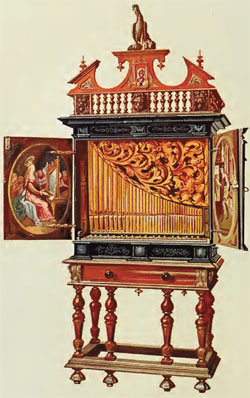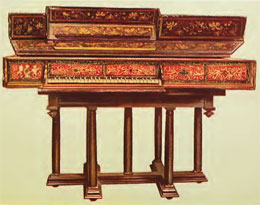Renaissance Instruments
The Renaissance instruments, many of them inherited from the Medieval times, offered a wealth of artistic possibilities.
A quick list of Renaissance instruments will include:
- - Keyboard instruments.
- - The stringed group: the lyra (hurdy-gurdy), various forms of lute, viols, harp, psaltery, dulcimer.
- - The wind group: the oboe, the flute, horns, bagpipes, trumpet, clarion and trombone.
- - Percussion instruments: drums.
Renaissance stringed instruments
- The HarpA typical example of the Renaissance instrument is the so-called Queen Mary Harp. It is fairly small, being only 31 inches high and 18 inches from back to front. However, like any Celtic harp, it has a strong framing, and can bear a considerable draught of wire.

Renaissance Positive Organ
The harp was played resting upon the left knee and against the left shoulder of the performer, whose left hand touched the upper strings. The twenty nine strings were made of brass. The sound was produced by the player's fingernails.
- The Psaltery and the DulcimerThe characteristic feature of these instruments is the sound box, formed by a rectangular or triangular case. Across the box are stretched strings of metal or sometimes of gut. The psaltery was played using the fingers or a plectrum, while with the dulcimer the strings are struck with two light hammers or rods of wood, and they have an increased weight to resist impact.
In the sixteen century, the psaltery, from which evolved keyboard instruments like the virginal, spinet and harpsichord, lost its position in favor of the dulcimer.
The stringed instruments with a fingerboard, touched with the fingers or a plectrum, can be divided into two principal types: the Lute and the Guitar. Guitars have flat backs, and lutes shell or pear-shaped resonance bodies.
The guitars can be sub-divided into the guitar proper which has cat gut strings, and cithers (or cetera in Italian), with wire strings necessitating the use of a plectrum.
Renaissance bowed instruments
- The viol is a guitar-shaped bowed instrument.Due to its sides depth and the flatness of the back the sound was soft and slightly reedy or nasal, but very penetrating. There was also the bass viol, named by Italians the Viola da Gamba. The viol was not yet as much valued as the lute, but its unique singing tone was appreciated.
- The violin, an instrument where sound and shape are intimately and inseparably connected, appears in England in the sixteenth century, where it was included in the King's Music. It was not quite appreciated by the English musicians of the period, and it was used more in rustic festivities.
Renaissance keyboard instruments
The main keyboard instruments were the organ, the clavichord, the harpsichord and their relatives. These were the musical instruments which had the greatest capacity for Renaissance concerted performances.
- The OrganThe Renaissance organ was of two kinds: the Positive which was intended to remain in a fixed place and the small portable organ, in use until after the Reformation. The disposition of the pipes was usually the same in both organs, ascending from the longest pipe in the bass to the shortest in the treble. For equal distribution of weight upon the sound board, some positive organs had the pipes arranged in a circular manner. The positive organ could be intended for chamber or choir use.
The earliest stringed instrument with balanced keys was the clavichord. Closely associated with the clavichord is the group of keyboard instruments composed of the virginal, spinet, and the clavecin or harpsichord, all based on the same principle. A keyboard instrument, named clavicytherium by the earliest writer on musical instruments, Virdung, is in fact a spinet set upright. The spinet was introduced in the second half of the fifteenth century.
A well-known keyboard instrument from the Renaissance period is the Queen’s Elizabeth Virginal. It may be argued that it is not a virginal proper, having more the appearance of an Italian spinet.
The generic term Virginal was the name under which all keyboard stringed instruments with jacks were known in Renaissance England. Sixteen century writers are mentioning that the name originated from the fact that the instrument was preferred by the ladies. The true virginal was usually of a parallelogram form, while a trapeze shape was usually associated with the spinet.

Queen Elizabeth Virginal
The Regal was a form of positive organ but provided with one or more reed stops. The metal reeds were of the clarinet or beating type. In the first part of the Renaissance period the name Regal was applied to any small organ which served a similar purpose, even though it did not wholly consist of reed pipes.
Percussion instruments
Popular Renaissance percussion instruments were the drum, tambourine, and other clashing, time marking instruments, as sistrums, cymbals, castagnettes, and triangles.
- Drum and FifeThe drum suspended at the side of the player and beaten on one head only, became, with its accompanying fife, the first organized form of military band. During Queen Elizabeth's reign, the size of the military drum was two feet in depth and two feet in diameter.
Wind Instruments
- HornThe horn was used mostly for war, and for hunting. In the large cities, it became associated with the municipal customs, and horns were used for example to sound the curfew. In the sixteenth century it was often made of wood, covered with leather or satin, and of brass. As length was increased, they were turned in a semicircle.
- The OboeThe instrument produces the sound by the vibration of two flat pieces of thin cane whose edges are set in motion by the breath of the player.
- TrumpetDuring the Renaissance, the Trumpet continued to be the instrument associated exclusively for noble purposes and pageantry. Initially it had a straight cylindrical tube of metal terminated by a spreading bell.
In the sixteen century, the Renaissance musicians began to experiment. On one hand they created compositions to be sung, like the motet or chanson. On the other, pieces like dances were written exclusively for instrumental use.
In early Renaissance many pieces were composed for a single instrument, but the idea to combine instruments followed quickly.Renaissance composers and the public began to recognize instrumental music as distinct from the vocal, and this was one of the most important advances of the 16th century.